DARK SKY HAPPENINGS - March 2022
Moab
UT (at City Hall)
38O34’ N Latitude
109O33’ W Longitude
4048 ft - 1234 m |
Embracing the Equinox
by David Prosper
Sunrise-Sunset
(The time of sunrise and sunset assumes a flat horizon. Actual time may
vary depending upon the landscape.) |
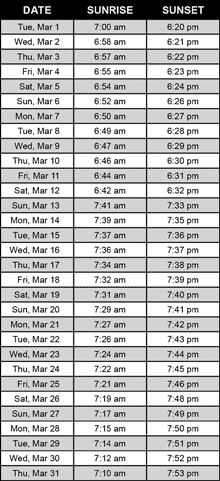 |
Depending on your locale, equinoxes can be seen as harbingers of longer nights and gloomy weather, or promising beacons of nicer temperatures and more sunlight. Observing and predicting equinoxes is one of the earliest skills in humanity’s astronomical toolkit. Many ancient observatories around the world observed equinoxes along with the more pronounced solstices. But what exactly is an equinox?
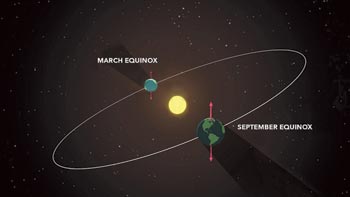 |
| This (not to scale) image shows how our planet receives equal amounts of sunlight during equinoxes. Credit: NASA/GSFC/Genna Duberstein |
An equinox occurs twice every year, in March and September. The equinox marks the exact moment when the center of the Sun crosses the plane of our planet’s equator. The day of an equinox, observers at the equator will see the Sun directly overhead at noon. After the March equinox, observers anywhere on Earth will see the Sun’s path in the sky continue its movement further north every day until the June solstice, after which it begins traveling south. The Sun crosses the equatorial plane again during the September equinox, and continues traveling south until the December solstice, when it heads back north once again.
Our Sun shines equally on both the Northern and Southern Hemispheres during equinoxes, which is why they are the only times of the year when the Earth’s North and South Poles are simultaneously lit by sunlight. Notably, the length of day and night on the equinox aren’t precisely equal; the date for that split depends on your latitude, and may occur a few days earlier or later than the equinox itself. The Sun itself is a sphere and not a point light source, so its edge is refracted by our atmosphere as it rises and sets, which adds several minutes of light to every day. The Sun doesn’t neatly wink on and off at sunrise and sunset like a light bulb, and so there isn’t a perfect split of day and night on the equinox - but it’s very close.
Equinoxes are associated with the changing seasons. In March, Northern Hemisphere observers welcome the longer, warmer days heralded by their vernal, or spring, equinox, but Southern Hemisphere observers note the shorter days – and longer, cooler nights - signaled by their autumnal, or fall, equinox. Come September, the reverse is true.
This is just a taste of the riches found within Orion’s star fields and dust clouds; you can study Orion for a lifetime and never feel done with your observations. To be fair, that applies for the sky as a whole, but Orion has a special place for many.
MOON HAPPENINGS
Mar 10 - First Quarter at 2:46 am
Mar 18 - Full Moon at 12:20 am
Mar 24 - Last Quarter at 10:39 pm
Mar 31 - New Moon at 11:27 pm |
Moab Dark Skies mission is to promote the appreciation and conservation of Moab’s valuable and rare dark skies. Moab Dark Skies was established by the Friends of Arches and Canyonlands Parks in conjunction with the National Park Service and Utah State Parks Division of Natural Resources
For more information, check out our Facebook page. |
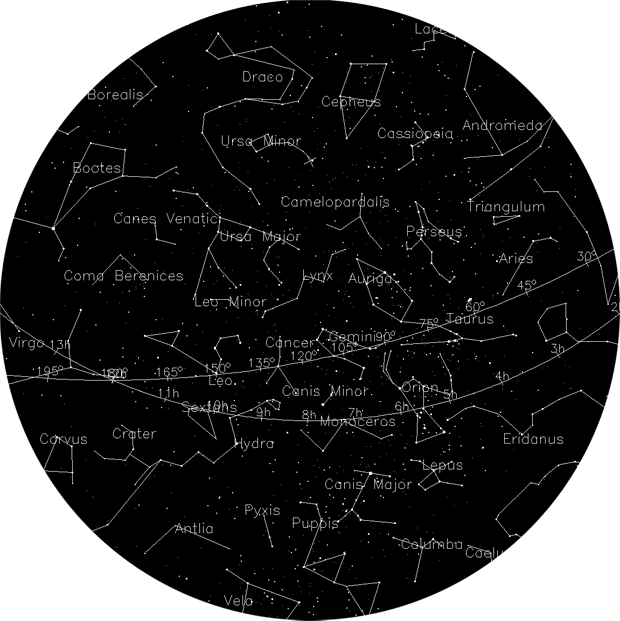 |
Check Your Sky Quality with Orion
by NASA Sky Network |
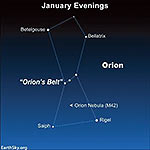
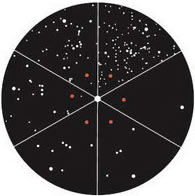 |
| The Dark Sky Wheel, showing the constellation Orion at six different limiting magnitudes. |
The brightness of planets and stars is measured in terms of apparent magnitude, or how bright they appear from Earth. Most visible stars range in brightness from 1st to 6th magnitude, with the lower number being brighter. A star at magnitude 1 appears 100 times brighter than a star at magnitude 6.
Your sky’s limiting magnitude is, simply enough, the measure of the dimmest stars you can see when looking straight up. So, if the dimmest star you can see from your backyard is magnitude 5, then your limiting magnitude is 5. Easy, right? But why would you want to know your limiting magnitude? It can help you plan your observing! For example, if you have a bright sky and your limiting magnitude is at 3, watching a meteor shower or looking for dimmer stars and objects may be a wasted effort. But if your sky is dark and the limit is 5, you should be able to see meteors and the Milky Way.
How do you figure out the limiting magnitude in your area? While you can use smartphone apps or dedicated devices like a Sky Quality Meter, you can also use your own eyes and charts of bright constellations! The Night Sky Network offers a free printable Dark Sky Wheel, featuring the stars of Orion on one side and Scorpius on the other, here: bit.ly/darkskywheel. Each wheel contains six “wedges” showing the stars of the constellation, limited from 1-6 magnitude. Find the wedge containing the faintest stars you can see from your area; you now know your limiting magnitude!
If you love Moab’s night skies, and enjoy expressing your creativity, consider participating in the
Moab Arts and Recreation Center dark sky themed exhibition! More information at
https://moabcity.org/599/Dark-Skies-Art-Show.
|
|